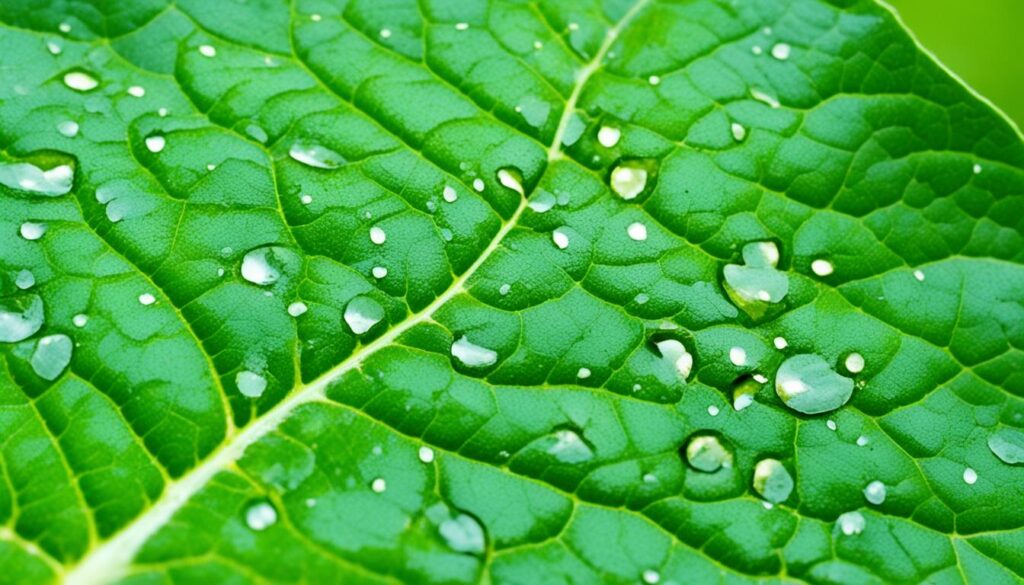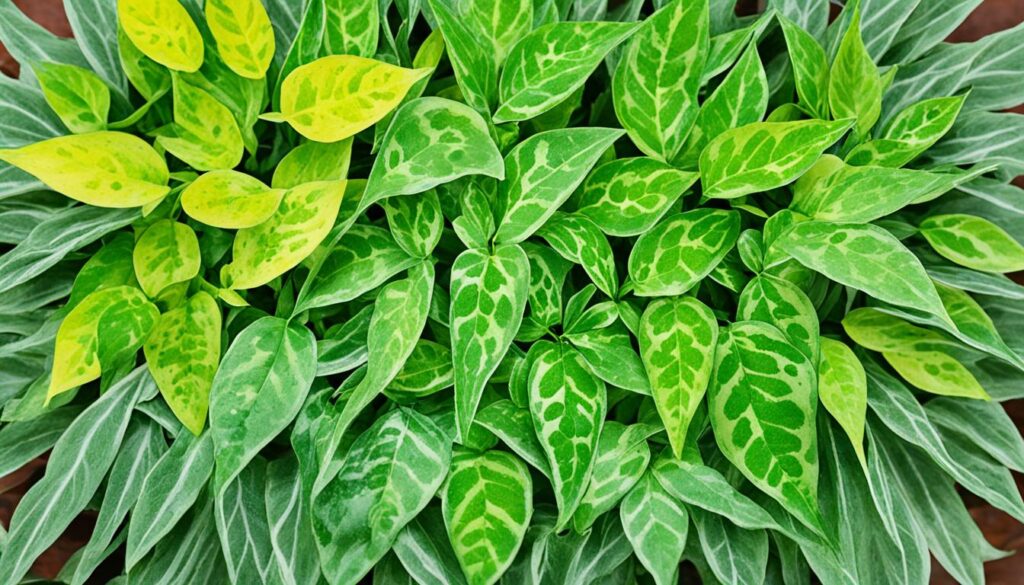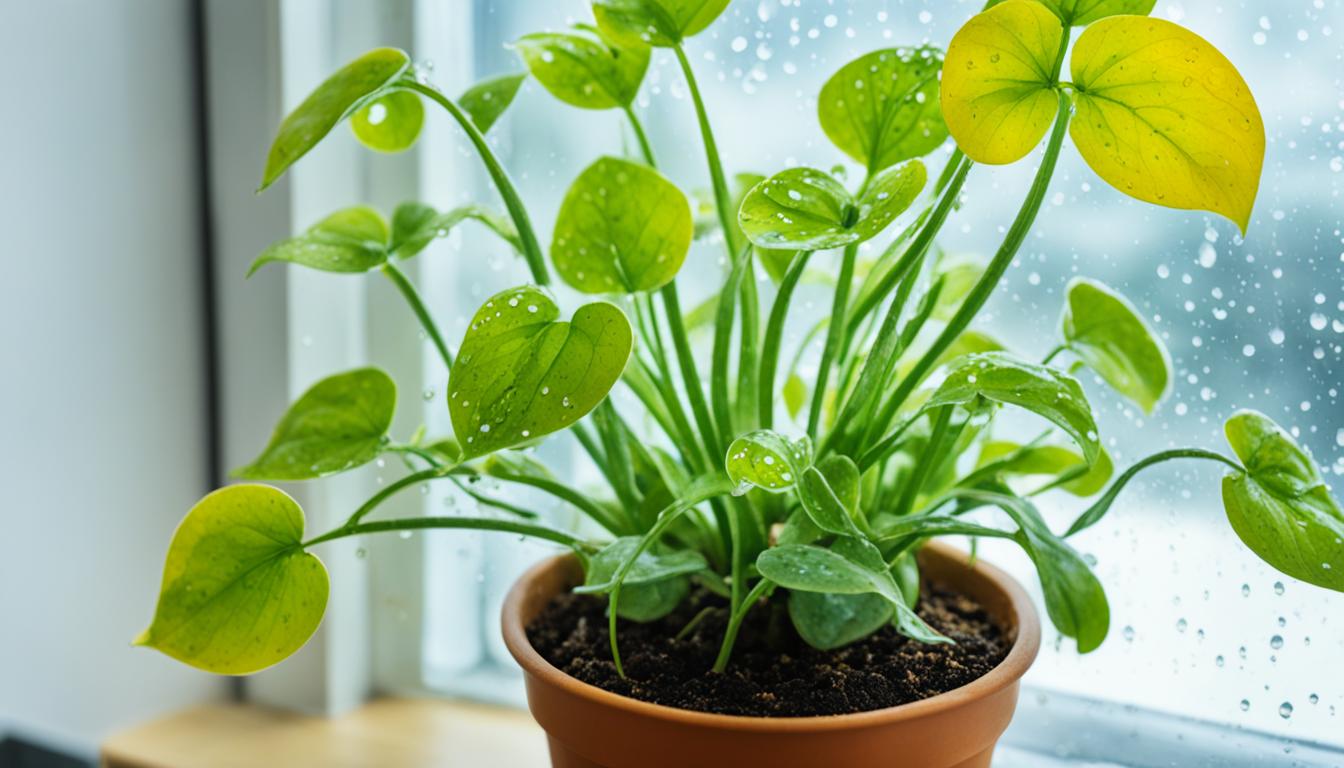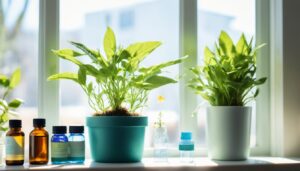Are your indoor plants facing leaf issues like discoloration, spots, wilting, or curling? It could be pests, lack of nutrients, or other factors. But how do you figure out the main problem and fix it? This guide will help you learn to spot the issues with your indoor plants.
Can you tell the difference between pests and nutrient issues? Finding out what’s wrong with your plant’s leaves is key to making it healthy again. Are you ready to fix the problem and bring back your indoor plants’ beauty?
Understanding Leaf Damage Identification
Knowing how to spot leaf problems is key to fixing them. Learn to recognize signs of pests and diseases to act fast. This helps protect your indoor plants. Get familiar with the damage signs of pests like aphids, capsid bugs, caterpillars, flea beetles, leafhoppers, leaf miners, and whitefly.
Identifying Pest and Disease Problems
Look closely at your plant’s leaves for odd spots or changes in color. These signs can tell you what’s wrong. For example, aphids leave behind a sticky substance, while leaf miners make trails in the leaf.
Common Pests and Their Leaf Damage Patterns
- Aphids – Cause leaves to turn yellow, curl, and distort, and leave sticky honeydew.
- Capsid bugs – Make brown, irregular spots on leaves.
- Caterpillars – Eat holes and rough edges in leaves.
- Flea beetles – Make small holes all over the leaf.
- Leafhoppers – Cause yellow or white dots on leaves.
- Leaf miners – Make trails of discolored leaf tissue.
- Whitefly – Make leaves turn yellow or fall off early, and leave sticky stuff behind.
Knowing these damage signs helps you figure out the problem. Then, you can fix it to keep your plants healthy.
Discolored Leaves: A Detective’s Approach
When your indoor plants show signs of leaf discoloration, spots, wilting, or curling, it’s time to investigate. These signs can mean many things, like pests or not enough nutrients. By looking closely at the leaves, you can find out what’s wrong and fix it.
First, take a good look at the affected leaves. Are the discoloration or spots mainly on the edges, margins, or tips? Are the leaves wilting or curling in? Where the changes happen can tell you a lot about the issue.
- Leaf discoloration can mean not enough nutrients, disease, or too much or too little light.
- Leaf spots might be from fungal or bacterial diseases, or pests like spider mites or thrips.
- Wilting leaves could be from not enough water, root rot, or problems with the plant’s water system.
- Curling leaves might be due to temperature, humidity, or chemical changes.
By watching the leaves and their patterns, you can guess what might be wrong. Each plant is different, so you need to be careful and try different things until you find what works for your plants.
| Leaf Symptom | Potential Causes |
|---|---|
| Leaf Discoloration | Nutrient deficiencies, disease, environmental stress |
| Leaf Spots | Fungal or bacterial diseases, pest damage |
| Wilting Leaves | Lack of water, root rot, other water-related issues |
| Curling Leaves | Changes in temperature, humidity, or exposure to chemicals |
“The key to solving any plant problem is to approach it with a curious and observant mindset, just like a seasoned detective.”
Nutrient Deficiencies and Their Telltale Signs
When you take care of your indoor plants, knowing the signs of nutrient deficiencies is key. These imbalances can affect the leaves, showing clear signs that help figure out the problem. We’ll look at the differences between mobile and immobile nutrient deficiencies. We’ll also cover the common symptoms of lacking essential elements like nitrogen, phosphorus, potassium, and more.
Mobile vs. Immobile Nutrient Deficiency Symptoms
Nutrient shortages can be either mobile or immobile, based on how the plant moves and uses the nutrients. Mobile nutrients, like nitrogen and phosphorus, can move around in the plant to help new growth. If they’re lacking, these nutrients first show up in the older, lower leaves. Immobile nutrients, such as magnesium, stay put and show up in the younger, upper leaves first.
Common Nutrient Deficiency Symptoms in Plants
- Nitrogen Deficiency: Older leaves turn yellow, growth slows, and plants get weak.
- Phosphorus Deficiency: Leaves turn dark green or purple, grow slowly, and make fewer flowers or fruits.
- Potassium Deficiency: Leaves get scorched or curled at the edges, mature late, and get sick easier.
- Magnesium Deficiency: Older leaves turn yellow between the veins.
- Calcium Deficiency: New growth is distorted, roots don’t develop well, and plants get sicker.
- Sulfur Deficiency: Younger leaves turn yellow, growth is slow, and flowering is delayed.
- Iron Deficiency: Young leaves turn yellow between the veins, with green veins.
- Zinc Deficiency: Leaves are small and distorted, and tips form rosettes.
- Manganese Deficiency: Leaves turn yellow between the veins and have brown spots.
- Copper Deficiency: Plants wilt, grow slowly, and new leaves are distorted.
- Boron Deficiency: Leaves get thick and brittle, and stems and flowers crack or deform.
- Molybdenum Deficiency: Leaves get scorched at the edges, grow slowly, and mature late.

Knowing these signs will help you spot and fix nutrient shortages in your indoor plants. This ensures they stay lush and healthy.
indoor plant leaf problems
As indoor gardeners, we’ve all faced the challenge of dealing with sick leaves on our houseplants. Pests and nutrient issues are common problems, but so are environmental factors. These include temperature, humidity, lighting, overwatering, and underwatering. By knowing how these affect your plants, you can fix the issues and keep your plants healthy.
Environmental Factors Contributing to Leaf Issues
Temperature changes can stress out indoor plants. If the temperature swings too much, leaves may wilt, curl, or turn color. Keeping the temperature steady is key for your plants’ health.
Humidity also affects your plants’ leaves. Too little humidity makes leaves dry out, while too much can cause fungal diseases. Finding the right humidity level is important for healthy leaves.
Lighting is crucial too. Not enough light can make plants grow poorly, turn yellow, and have droopy leaves. Too much sunlight can burn the leaves. Picking the right spot with the right light is important.
Overwatering and underwatering can harm your plants’ leaves. Overwatering causes roots to rot and leaves to turn yellow or wilt. Underwatering makes leaves dry and break easily. It’s important to water your plants the right amount based on their needs.

Understanding these environmental factors helps you create the best conditions for your indoor plants. This way, you can enjoy their healthy, beautiful leaves for a long time.
Diagnosing Root Causes: A Holistic Approach
To fix leaf problems in your indoor plants, look at the whole plant, including roots and soil. Knowing the root causes helps you find the right solutions to make your plants healthy again.
Examining Root Health and Soil Conditions
Root health and soil quality are crucial for your plants. Check the roots for damage, discoloration, or rot. Healthy roots are firm, white or light-colored, and smell good. Fix root rot or issues quickly to stop them from harming the plant.
Also, check the soil’s condition. Things like pH, nutrient levels, and drainage affect your plants. A soil test can show you what’s wrong with your potting mix and help you fix it.
| Soil Test Parameter | Optimal Range | Potential Issues |
|---|---|---|
| pH | 6.0 – 6.5 | Nutrient deficiencies, root rot |
| Nitrogen (N) | 20-50 ppm | Yellowing, stunted growth |
| Phosphorus (P) | 10-30 ppm | Purple discoloration, poor root growth |
| Potassium (K) | 30-100 ppm | Leaf edge browning, stunted growth |
Fixing root and soil problems helps solve your plant’s leaf issues. This approach gives you the insights you need to make your houseplants healthy again.
“The key to healthy plants lies in the roots and the soil they grow in.”
Plant Analysis: Unlocking the Nutrient Puzzle
Plant analysis is key to solving leaf problems in indoor plants. By sending plant tissue samples to labs, you learn about your plants’ nutrient levels. This helps find any shortages or imbalances that might be causing problems.
Submitting Plant Samples for Analysis
Submitting plant samples for analysis is easy and gives deep insights into your plant’s nutrition. Here’s how to do it:
- Identify the problem areas: Look at your plants and note any discoloration, wilting, or distress on the leaves.
- Collect representative samples: Take a few healthy leaves from the problem spots and some from healthy parts.
- Package the samples properly: Put the leaves in a clean, dry bag or envelope, and be careful not to crush them.
- Send the samples to a reputable laboratory: Find a lab that specializes in nutrient analysis for plants for reliable results.
- Follow the laboratory’s instructions: Give them any extra info they ask for, like the plant type, growing conditions, or recent treatments.
After analyzing the plant samples, the lab will give you a detailed report. It will show the levels of different nutrients in your plant. This info is crucial for finding nutrient deficiencies or imbalances that might be causing leaf problems.
Using the insights from plant analysis, you can adjust your care to meet your plants‘ specific needs. This leads to healthier, more vibrant plants.
Conclusion
Now you know the main reasons behind leaf problems in indoor plants, like pests, diseases, nutrient issues, and environmental factors. This knowledge lets you become an expert in plant health. Use the tips and methods from this guide to find and fix the main problems with your indoor plant leaf problems.
With a deep understanding of plant health, you can keep your houseplants healthy and thriving. You won’t have to guess or feel lost when dealing with diagnosing and treating leaf issues anymore. You can take steps to prevent problems and keep your plants looking great.
The secret to success is a careful, detailed approach. Observe your plants, look at the symptoms, and fix the root causes. This way, you can make your indoor plants healthy again and enjoy their beauty in your home for many years.
FAQ
What are the common causes of leaf problems in indoor plants?
Leaf problems in indoor plants often come from pests, not getting enough nutrients, and bad environments. This includes things like wrong temperature, humidity, and light levels. Also, overwatering or underwatering can cause issues.
How can I identify the signs of pest and disease problems on my indoor plant leaves?
Look for pest and disease signs by checking the damage on your plant leaves. Common pests like aphids and whiteflies leave specific marks. Knowing these signs helps you spot problems early.
What visual cues should I look for to diagnose leaf discoloration, spots, and other changes?
To spot leaf problems, look at the color, spots, and how the leaves are shaped. These signs can tell you if your plant lacks nutrients or if it’s in a bad environment.
How can I identify nutrient deficiencies in my indoor plants based on leaf appearance?
Spot nutrient shortages by noticing how the leaves look. Some nutrients like nitrogen and phosphorus show clear signs. Knowing these signs helps you fix the problem.
What environmental factors can contribute to indoor plant leaf problems?
Many things can harm your indoor plants, like the wrong temperature or too much water. These issues can make leaves turn color, wilt, or curl.
How can I assess the overall health of my indoor plants, including their root systems and soil conditions?
Check your plants’ health by looking at their roots and soil. This helps you find the main cause of leaf problems. Then, you can fix them effectively.
How can plant analysis help diagnose nutrient deficiencies and imbalances?
Plant analysis is key for finding nutrient problems in your plants. By testing plant samples, you learn about nutrient levels. This helps you fix any shortages or too much of something.




